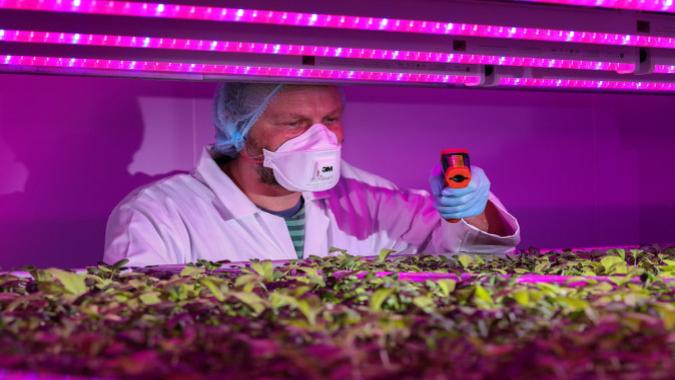Optimizing Greenhouse Crop Yields with LED Lighting

Founded in the 1990s (as GELcore), Current is first and foremost known for designing light-emitting diode lamps and fixtures (LED). But an employee from the very beginning quickly sensed an opportunity in something he knew well: food.
Eden Dubuc still works for the company as a senior technology architect (“I still have my first job,” he laughs). His family’s business produces some 15,000 tons of onions and carrots per year. To test the first prototypes of Current’s LED horticulture lighting systems, Eden Dubuc borrowed one of his father’s greenhouses. The company also conducted research on the needs of plants in collaboration with Savoura, a large tomato producer in Quebec.
Today, Current LED lighting is found in the largest greenhouses and vertical farms across the United States and Europe, as well as the Lufa Farms’ greenhouses in Quebec just down the road from where it all began.
The advantages of LED technology in horticulture
The energy efficiency of LEDs is one of their main advantages, even in places like Quebec, where greenhouses frequently need to be heated. Jordan Goulet, Current’s partner at Hort Americas Canada, explains why: “Between mid-March and the end of October, traditional lighting systems give off too much heat. It is necessary to either open the greenhouse valves, which causes losses of carbon dioxide which adversely affects plant growth, or be satisfied with sunlight, which is irregular. With LEDs, which give off little heat, we can benefit from optimal lighting for the needs of a specific crop throughout the year.”
The advantages even extend to the quality of foods, according to Michel Doss, vice-president in charge of specialty products at Current. “By providing lettuce with more blue light, for example, we can influence its taste, shape, and color.” A plant grown under LEDs can also last two times longer on grocery shelves, which reduces food waste. Finally, by combining LED lighting with a mechanical heating and ventilation system, a producer can accurately control the temperature of their greenhouse while saving between 50% and 60% of their electricity bill.
A step towards food self-sufficiency?
The development of greenhouse horticulture may also contribute to the food self-sufficiency of Quebec, an issue propelled to the fore by the current pandemic.
“We greatly depend on California and Mexico for our fruits and vegetables,” says Michel Doss. “These territories benefit from free and abundant sunshine, which gives them an undeniable competitive advantage, but the pandemic has put a lot of pressure on the distribution chain. In addition, climate changes make cultivation in the field very risky. For a farmer, working in a controlled environment can be an excellent insurance policy.”
An innovation center in Quebec
Current has invested considerable sums in making Montreal its international center for design and development of lighting systems for horticulture. The company also intends to expand its activities to include the entire digital greenhouse sector. “In the case of lettuce, there are 800 factors which influence growth,” explains Eden Dubuc. “Lighting barely represents thirty!”
In the meantime, the company is betting on its 25-year experience to win the favor of producers. “We have learned from our experience in various segments of the lighting systems market,” assures Eden Dubuc. “When you produce traffic lights, you can't afford to change bulbs every six months. With railway signaling, it must be reliable in order to avoid accidents. This is what we offer to our customers: a long-lasting production tool.”






